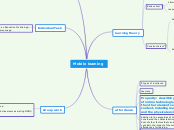Mobile learning
learning theory
Cognitivism
mind as an information processor
transfer of knowledge
students remember rules,patterns and stratrgies
Behavorism
stimulus
IT environment
response
feedback
Constructivism
Social Constructivism
Knowledge Construction
Mostly use Presentation, group work, feedback to create knowledge rather than receiving and processing knowledge
Agreement and discussion between student's ideas
on ICT tool, such as facebook
Pre-reading materials are mostly read and absorted
as knowledge processing
Presentation: the pointed group would
make the knowledge construction and opitions, give the
problems to other groups.
Feedback between teacher and student via,
for example feedback form and blog
Subtopic
affordance
9 types of intellence
taxmony
Properity: describing how attributes of online technologies interact with the other elements of a learning context, including learners, teachers and the physical environment.
key affordance of wikis is the collaborative construction of knowledge
Addition to the properties of the technologies, she has considered the characteristics of the learners and a host of other factors that can act to enhance or constrain the impact of the technologies on affordances for learning.
there must be other factors present in the learning context that are interfering with the actualisation of the affordance by the other students
To express the relationship between this set of mechanisms and classroom activities, we borrow the term affordance
software design
Individual Task
developing an Education Mobile App:
MOOC classroom app
Design Plan
1,purpose and learning outcomes:
learn MOOC course with mobile app
targeted learners
structure template : ID and technology
evaluation of learning and teaching
2,USE CASE and Interface design
1,vote
2,video
3,e-book
4,rating and ranking
5,peer to peer assessment
.........
3 affordance of ICT??
MOOC elements
more reading
make a app
4, function of the product
5, progress of the product
Group work
design activities and scene:
Software Toolkit for flipped classroom assisting MOOC, 2000 words
case study:
A few design perspectives
on one-on-one digital classroom environment
educational activities:
teacher-directed instruction
small group learning
individual learning
digital classroom components
Student devices:
Communication network
Classroom-shared display
Teacher’s device
Classroom servers
Device management system
Communication affordance ~~ Examples of educational applications
